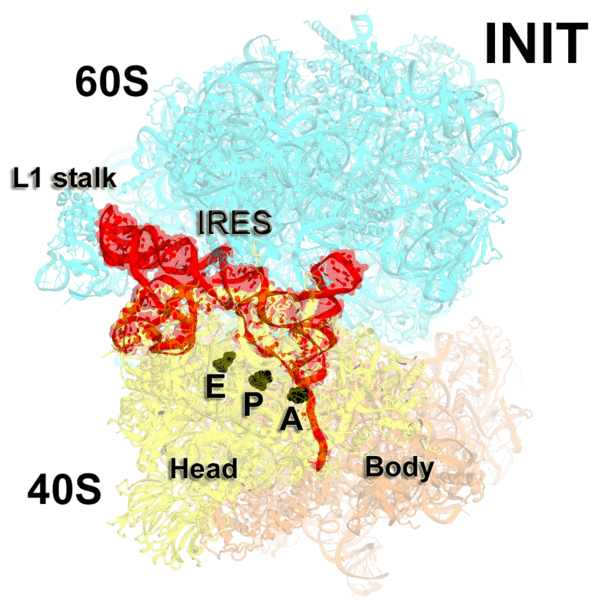Mechanisms of Translation Regulation
Understanding Viral Gene Expression
Viral mRNA can efficiently hijack host ribosomes during infection for translation of proteins necessary for virus propagation. Initiation of translation is a key step, during which the coding region of mRNA, open reading frame, gets properly positioned on the ribosome. Cryo-EM (electron cryo-microscopy) structures of the ribosome-bound Taura syndrome virus (TSV) messenger RNA (red) reveal a structural mechanism of initiation on viral mRNAs. Dicistroviridae intergenic sequences, known as the internal ribosome entry sites (IRES), initiate translation by binding their tRNA-mRNA–like element - pseudoknot I (PKI) - in the aminoacyl-tRNA site (A site) of the ribosome, as described in Koh et al. "Taura syndrome virus IRES initiates translation by binding its tRNA-mRNA-like structural element in the ribosomal decoding center" (Proc Natl Acad Sci U S A. 2014).
Following the initial binding (INIT), the viral IRES mRNA is translocated by elongation factor eEF2 from the A to P site - to allow binding of the first tRNA and translation initiation. Cryo-EM allowed us capturing an ensemble of intermediate structures at 3.5- to 4.2-A resolution (structures I through V). They describe a nearly complete trajectory of TSV IRES translocation, bringing several new insights into ribosomal dynamics and the role of translocase eEF2 (Abeyrathne et al. "Ensemble cryo-EM uncovers inchworm-like translocation of a viral IRES through the ribosome". eLife. 2016).
Click on the image above to see a more detailed view of TSV IRES translocation by eEF2.
